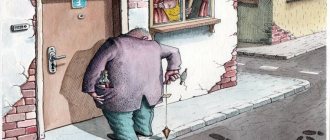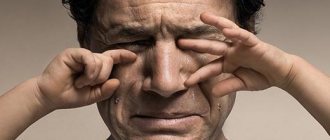Sleep is a necessary phase of human life. And the work of mental processes (thinking, memory, attention), and the emotional mood during the working day depend on its quality. Therefore, any disturbances in the process of night rest have a negative impact on our lives. The onset of untimely muscle weakness, or sleep paralysis, are always alarming symptoms of disorders in the brain. In addition to a sudden weakening of muscle tone and loss of control over the body, this condition is characterized by unpleasant subjective and objective sensations.
What is sleep paralysis
The state of immobility and muscle weakness (atony), which is absolutely normal for a good night’s rest, sometimes occurs before the moment of falling asleep or persists after the moment of awakening. Short-term sleep paralysis with full consciousness always disturbs a person, giving rise to panic feelings. This mysterious and not fully explained phenomenon is observed in the borderline state between sleep and wakefulness and does not last long. The condition goes away on its own and is officially considered harmless. But within a few seconds (several minutes, rarely hours) of unusual and unconditional immobility (paralysis), a sleepy person can experience a real shock.
Symptoms
The condition of sleep paralysis is characterized by symptoms:
- visual disturbances (hallucinations, out-of-body experiences, and otherworldly experiences);
- auditory disorders (auditory hallucinations, “voices”, the appearance of tinnitus, turning into a squeak);
- false body movements (the complete impression or experience of turning over from side to side, moving limbs during an attack);
- a feeling of the presence of a stranger or a frightening entity in the room, vestibular motor sensations, “alien abduction”;
- inability to speak;
- difficulty breathing (up to the impossibility of breathing).
It is believed that the sudden awareness of a paralyzed, and therefore uncontrollable and defenseless, body activates a system for responding to a threatening (uncertain) situation, evolutionarily built into the midbrain. This brain structure sends an alarm signal to the thalamus-amygdala system, which forms the general emotional background. In a potentially life-threatening situation, a synthesis of dreams that characterize the rapid stage of sleep and alarm signals occurs. This gives rise to hallucinations. And if a person has problems with the respiratory system (rapid breathing, hyperventilation, apnea), there is a feeling of being suffocated by a hostile entity, and the inability to breathe.
Causes
Recent large-scale studies by Western scientists have revealed that attacks of sleep paralysis occur in 8% of respondents. Students (28% of respondents) and patients of psychiatric clinics (32%) are at risk. Men and women were equally susceptible to this unpleasant pathology. Among people of the most working age (up to 30 years), more people suffering from this disease were identified (about 40%) than among people of more mature age (only 5%). But most often (up to 50% of patients with this pathology) sleepy stupor was observed in people suffering from a chronic pathology of the nervous system - narcolepsy.
Statistics clearly indicate that the factors and causes of paralysis lie in the dysfunction of the central nervous system. But the effects themselves can be internal, as in the case of narcolepsy, or purely external. The main causes of sleep paralysis are:
- organic (genetically determined) or functional (neuroses, migraines) pathologies of the nervous system;
- destructive sleep apnea;
- vitamin deficiency (hypokalemia);
- intoxication of the body (smoking, alcoholism, drug addiction, large doses of medications and long courses of drug therapy);
- sudden (situational) change in daily routine (night shifts, frequent air travel with changes in time zones);
- physical and mental fatigue (stress, overload, nervous exhaustion);
- insufficient (less than 8 hours) or restless (with frequent awakenings) sleep.
Researchers and sleep specialists believe that attacks of sleep stupor may be associated with the mutual overlap of the phases of awakening and REM sleep. Overactivity of cholinergic neurons (responsible for sleep) and low activity of serotonergic neurons (responsible for awakening) lead to the inability to activate certain brain structures. During normal sleep patterns, the activity of serotonergic neurons increases throughout the REM sleep stage. But in people with sleep paralysis, their signals are almost completely blocked.
Principles of treatment
Doctors recommend fighting sleep paralysis if it causes other sleep disorders, such as insomnia. Treatment also needs to be started if attacks occur regularly. Therapy is based on the following components:
- normalizing sleep and wakefulness;
- maintaining physical activity;
- fight against bad habits;
- regular ventilation of the recreation area;
- relaxation before falling asleep by taking baths, aromatherapy;
- consumption of vitamins;
- compliance with the rules of proper nutrition.
You can also fight by treating chronic pathologies.
Drug therapy
Since sleep paralysis is not an officially recognized disease, there are no specific medications for its treatment. Medicines to combat this condition help normalize falling asleep and strengthen sleep:
- Metalonin;
- Vita-melatonin;
- Neurostable.
Medicines are prescribed only if other treatments do not work.
Vitamin course
To cope with the occurrence of sleep paralysis, it is necessary to combat stress that negatively affects the immune system and the general condition of a person. You can cope with this deterioration with the help of vitamins. Night paralysis should be treated with a vitamin-mineral complex, which includes:
- ascorbic acid;
- potassium;
- magnesium;
- vitamin A, B, D, E.
The duration of vitamin therapy is determined by the doctor.
Physiotherapeutic treatment
Physiotherapy can prevent sleep paralysis. Sleep disorders can be cured using the following procedures:
- massage;
- electrophoresis;
- electrosleep therapy;
- acupuncture;
- aerotherapy;
- galvanization of the collar area;
- electrosona.
Taking relaxing baths with essential oils, salts, and iodine added to the water can also help cope with attacks.
Kinds
An attack of sleep paralysis can overtake a person during:
- falling asleep, when the body diagram (body position, sensations from internal organs) and motor skills (the intention and ability to make a movement) are still retained in consciousness; the body is already completely relaxed, and the person is in a semi-conscious state, so hypnagogic sleepy stupor in most cases goes unnoticed;
- awakening; Hypnopompic sleep paralysis is the return of consciousness after the REM sleep phase, when the body has not yet returned to the ability to move or say something.
In the international classification of this disease, one of the types is isolated sleepy stupor, which is short-term, and often one-time, in nature. The specific features of recurrent isolated sleep stupor are the duration, and sometimes recurrence, of attacks, and its chronic (often lifelong) nature. Both types of paralysis are observed upon awakening.
Description
Paralysis is the complete loss of muscle strength in a muscle or group of muscles.
This condition is not an independent disease, but is considered only a consequence of a disease, that is, a sign of it. It occurs in males and females of all ages.
The following classification of paralysis is distinguished, based on the prevalence of the process:
- monoplegia – paralysis of one limb on one side of the body occurs;
- paraplegia - paralysis of two limbs of the same type, for example, both arms;
- hemiplegia – paralysis develops in the limbs on one side;
- tetraplegia - four limbs are simultaneously affected.
Depending on the origin of paralysis, the following forms are distinguished:
- central (spastic) paralysis – characterized by increased tone in paralyzed muscles;
- peripheral (flaccid) – characterized by a decrease in tone in the affected muscles, as well as the development of their hypotrophies and atrophies.
The causes of paralysis are varied. We offer to your attention the following:
- ACVA (acute cerebrovascular accident);
- tumors of the brain and spinal cord;
- brain and spinal cord injuries;
- infectious diseases of the nervous system, for example, tick-borne encephalitis;
- demyelinating diseases - are associated with the destruction of the protein that ensures the conduction of nerve impulses through fibers - myelin. Such diseases include: multiple sclerosis, multiple encephalomyelitis and others;
- immunoinflammatory diseases, in particular Guillain-Barré syndrome;
- myopathies – diseases based on congenital or acquired metabolic disorders in muscle tissue;
- myasthenia gravis – a disease characterized by pathological muscle fatigue;
- poisoning, in particular with alcohol, industrial poisons, salts of heavy metals, nerve poisons.
The prognosis largely depends on the factor that caused the development of paralysis. In most cases, it is possible to achieve complete or partial restoration of muscle strength. However, in some cases, muscle paralysis cannot be corrected. It is also important to remember about possible complications, in particular the formation of contracture and ankylosis of the joints. That is why you should carefully follow all the recommendations of the attending physician, since the successful outcome of the treatment of paralysis largely depends on the patient himself and his relatives.
Diagnostics
It is not always necessary to seek advice from a specialist in case of sleepy stupor. This may be justified if a person is bothered by attacks of immobility that occur after waking up, or they interfere with his normal functioning. In the arsenal of a modern somnologist there are the following methods for diagnosing sleep paralysis:
- Polysomnograph: the absence of changes in the polysomnogram confirms the safety of brain structures and excludes more serious causes of unpleasant attacks.
- Genetic analysis: absence of changes excludes the possibility of narcolepsy.
- An electrooculograph that records the movements of the eye muscles and the outer layer of the retina during the rapid stage of night rest.
At the first visit, the somnologist will ask you to fill out a questionnaire about past infectious diseases and hereditary pathologies associated with sleep.
Psychology point of view
Nightmares from sleep paralysis, according to psychiatrists, are not dangerous to the psyche of a healthy person. But if a person is emotionally unstable (this especially applies to women who are more susceptible to everything), there may be problems associated with the fear of death, the feeling of falling into a coma.
This is due to the fact that the hallucinations accompanying the phenomenon are very realistic, and the defenselessness of a paralyzed body is frightening. Sleep paralysis is quite often accompanied by auditory hallucinations, when the sounds of the outside world are distorted, amplified, and supplemented by echoes of a dream that has not yet completely left.
How to treat sleep paralysis
Patients who turned to a somnologist with the question “how to get rid of disturbing attacks of sleep paralysis?” must be prepared to change their lifestyle. As a rule, this condition signals constant mental stress, overload with affairs and worries. Therefore, the main treatment is to limit daily activity and give up some physical and intellectual activities. It will help to normalize your sleep schedule, eliminating activities that disturb a person before a night's rest (watching action-packed films, conflicts). Sometimes it is useful to consult a psychologist or psychotherapist. A specialist can suggest ways and means of overcoming stress and bustle.
During short-term (several minutes) attacks, it is important not to panic, not to resist the condition, but to distract yourself with simple mental work (remember poetry or the multiplication table); after the attack ends, you need to wash your face with cold water and take a shower. But if the condition has become chronic, the only way out is to take antidepressants prescribed by your doctor.
How dangerous is it and does it need to be treated?
Modern medicine considers sleepy stupor a safe, but strange and incomprehensible condition, because normally the human body and consciousness should sleep and be awake simultaneously.
However, given the symptoms described above, there is nothing good about it. A patient who is unprepared, uneducated, or who believes in supernatural phenomena may experience such fear that can lead to dire consequences, such as heart attack, stroke, miscarriage during pregnancy, and other results of severe stress.
Considering that some of the causes of the syndrome are stress and a weak psyche, it can lead to a deterioration in a person’s condition and self-aggravate.
Considering the discomfort that this disease causes, it is still worth getting rid of it.
Prevention
Following simple rules can significantly reduce the risk of stupor upon awakening:
- Stick to a regular bedtime schedule.
- Spend enough time organizing your sleeping area (comfortable bed with an orthopedic mattress and anatomical pillow), maintain sleep hygiene (cool, well-ventilated room).
- Choose the right position for rest: paralysis more often overtakes those who sleep on their back.
- Limit your intake of stimulants and strong medications.
- If necessary, consult a psychologist (psychotherapist).
If a person does not have problems with the respiratory system (bronchial asthma, sleep apnea), which increase the natural feeling of fear, then the state of sleep paralysis is safe and goes away on its own.











